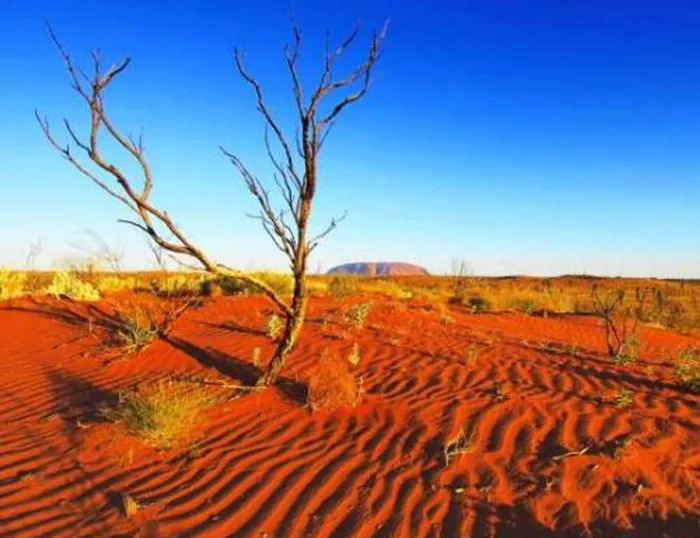The giant of Australia

Uluru does not announce itself. No foothills predict its coming, just this titanic, thousand-foot hump of scorched red rock erupting from the rippling sandhills of the central Australian desert as suddenly as a breaching whale exploding from a still sea.
Despite The Olgas, the rock domes that are just visible on the horizon, rearing higher and broader from the desert floor, it is the sheer, fused bulk of Uluru that captures the imagination.
No wonder Australians refer to it simply as "The Rock".
Australians took a long time to find Uluru. It was not until 1872 - almost a century after white settlement - that a European explorer, Ernest Giles, set eyes on it. The following year another explorer, William Gosse, became the first white man to stand on its summit.
It was Gosse who gave Uluru its European name, Ayers Rock, after Sir Henry Ayers, governor of South Australia at the time. Since then, Uluru has become the most recognisable Australian landmark, and Australians have embraced it as fitting metaphor for the grandeur, the isolation, the weird other-worldliness of their continent.
Close up, the physicality of Uluru is overwhelming. No longer is it a smooth dome but a scarred colossus with the evidence of eons of sun and rain etched on its pitted hide.
The monolith is composed of arkose, a type of sandstone, formed from compressed sediments laid down on the sea floor about 600-million years ago. There are no fossils. This was the dawn of life on Earth, and no organism had evolved beyond simple marine invertebrates.
Uluru has a different mood for every time of day. Pink in the early morning, it becomes rust in the blazing light of midday. At sunset, the iron-rich rock glows molten red with a slow-burning fire that seems to come from within.
When it rains - a rare occurrence in this part of the world - the water cascading from the rock can turn it purple or green.
The ascent of Uluru is virtually a rite of passage for many of the hundreds of thousands of tourists who visit each year. From the parking lot at its base, a well-marked path scales the rock face to the top of the 348m dome. A chain provides handholds for the steepest section of the climb, where the trail rockets up the face at a lung-busting 45 degrees.
The one-hour climb to the summit is not to be taken lightly.
Every year several people die climbing Uluru, mainly from cardiac arrest.
Although the ascent is by far the most popular activity in the area, out of deference to the Aboriginal people of the region, many now choose to walk the 10km trail around its base.
Along with its physical presence, Uluru has a spiritual dimension that cannot be ignored.
Stand with your back against it, close your eyes and you can sense that there is something elemental about this hunk of rock, a connection with the very roots of life. This is a rock with power.
Aborigines, who refer to themselves as Anangu in this area, have lived in the shadow of Uluru for perhaps 30 000 years.
Nomadic hunter-gatherers who meshed their lives with the land around them, they are connected to the earth in a profound way that enables them to know where to find water in a parched landscape; where to dig for honey ants; how long ago a red kangaroo left its prints in the soft sand; and when to expect rain from a cloudless sky. For the Anangu, Uluru resonates with sacred meaning.
According to their view of the world, Uluru - and every other feature and being in the landscape - was created by giant ancestral beings who roamed the land in a period known as the Dreamtime, sculpting the rocks, rivers and hills.
Each of the caves, hollows and scars of Uluru bears witness to those ancestors. Streaks in the rock might be blood that seeped from a wound, a line of rocks might be footprints, a particular cave might be the sleeping place of a giant lizard.
There are men's areas, where women would never go or even glance, and women's sites.
Only those who have been initiated to the required level will ever see the sites that are most sacred. To the visitor, much of the significance of Uluru is unfathomable. Even when the sites are identified and explained, and even when you come armed with the best of intentions, you cannot experience Uluru through Anangu eyes.
At Uluru, an understanding of the world based on rational precepts meets a brick wall.
This is a world beyond our grasp. The true meaning of Uluru is how little we understand. Accept that and you come away with hands full.
- Several styles of accommodation are available at the Ayers Rock Resort Village - from camping to deluxe. Get more information about Longitude 131, a luxury wilderness camp with elevated individual lodges from www.longitude131.com.au.